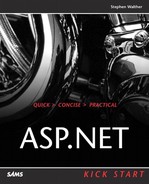This is an introductory book on creating ASP.NET Web applications using Microsoft Visual Studio .NET. The focus of this book is the Visual Studio .NET development environment. You will learn how to take full advantage of the features of the Visual Studio .NET development environment to quickly develop professional Web applications.
The material in this book is organized around step-by-step walkthroughs of common programming tasks that you'll encounter when building Web applications. Each walkthrough was written to be detailed enough to stand on its own.
Each and every code sample in this book is presented in both C# and Visual Basic .NET. These are the two languages supported by Visual Studio .NET that are widely used when building Web applications. No preference is given to one language over another.
This book was written for professional developers who need to quickly get started building Web applications using Visual Studio .NET. The intended audience includes two groups of developers.
First, the book was written for the developer who is migrating to ASP.NET from another technology, such as Java, Cold Fusion, PowerBuilder, or ASP Classic. If you are new to ASP.NET, you can use this book as an introduction to ASP.NET and the Microsoft .NET Framework. This book starts with the basics and works through to advanced features of the ASP.NET Framework.
Second, even if you are an existing ASP.NET developer, you can use this book to learn how to take advantage of the tools included in Visual Studio .NET for building Web applications. By fully taking advantage of the tools included in Visual Studio .NET, you can save yourself a substantial amount of development time.
This book is divided into four parts. The first part, “Building Web Form Pages,” concentrates on the features in Visual Studio .NET for building individual Web Form Pages. You are provided with an overview of the Visual Studio .NET environment. You are introduced to the different types of Web Form controls that can be found in the Toolbox. Finally, the important topic of debugging your applications is discussed.
The second part of this book, “Working with Database Data,” is devoted to the topic of creating database-driven Web Form Pages. In this part, you learn how to take full advantage of the tools included with Visual Studio .NET for working with databases, such as Microsoft SQL Server and Microsoft Access. For example, you learn how to use a DataGrid control to display, sort, and edit database data. You also learn how to save Form data to a database table.
The third part of this book, “Working with ASP.NET Applications,” covers a variety of different topics. This part includes a chapter on improving the performance of your applications through caching. You also learn how to password-protect folders in your application with Forms Authentication. Finally, you learn several methods of deploying a completed application.
The final part of this book, “Components, Web Services, and Custom Controls,” discusses three topics associated with creating custom classes. In this part, you learn how to create multi-tiered applications by separating your application logic into business components. You also learn how to take advantage of XML Web services to expose your business components to the Internet. The last chapter of this book discusses how you can extend the basic ASP.NET Framework by creating new Web Form controls.
If you have experience with another programming language, such as Java, Visual Basic, or C++, you should have very little trouble understanding the code samples. Java and C++ developers will find C# code very familiar. Visual Basic and VBScript developers will find Visual Basic .NET very familiar. Every code sample is presented in both C# and Visual Basic .NET.
To get the most out of this book, you should also have some background in working with a database, such as Microsoft SQL Server or Microsoft Access. You'll need to know basic SQL to understand the database chapters.
The following typographic conventions are used in this book:
Code lines, commands, statements, variables, and any text you see onscreen appears in a
monotypeface.Bold monotypeface is used to represent the user's input.Placeholders in syntax descriptions appear in an
italic monotypeface. Replace the placeholder with the actual filename, parameter, or whatever element it represents.Italics highlight technical terms when they're being defined.
The
 icon is used before a line of code that is really a continuation of the preceding line. Sometimes a line of code is too long to fit as a single line on the page. If you see
icon is used before a line of code that is really a continuation of the preceding line. Sometimes a line of code is too long to fit as a single line on the page. If you see  before a line of code, remember that it's part of the line immediately above it.
before a line of code, remember that it's part of the line immediately above it.The book also contains Notes, Tips, and Cautions to help you spot important or useful information more quickly.
